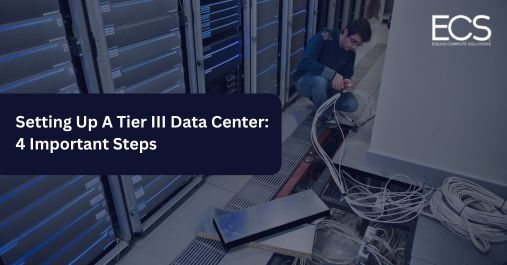Building a Tier III data center is a complex undertaking that requires meticulous planning, precision, and adherence to strict standards to ensure high availability and reliability. Tier III facilities are designed to offer 99.982% uptime, meaning they can only afford about 1.6 hours of downtime per year. Achieving this level of performance demands careful attention to every aspect of the build, from the initial design to the final fit-out. In this article, we’ll break down the essential steps involved in constructing a Tier III data center, outlining the key considerations and best practices for each phase.
Step 1: Shell Structure
The walls, roof, and flooring systems of a data center make up the physical environment that houses all of a facility’s systems, so it must be built before any major internal installations. The most important of these is flooring, as it is key for efficient cabling, airflow management, and hot/cold aisle containment.
For Tier III data centers, the foundation and structure should be built to collectively support a Tier III facility’s uptime requirement: resilient against natural disasters and other external threats using high-quality materials and construction methods that are essential to ensure long-term reliability and durability. This is also where a savvy data center can include considerations for future expansion and environmental impact.
Step 2: Power Infrastructure
Ideally, as the outside shell is being built some aspects of the power infrastructure can begin, namely the process of linking to the local power grid and beginning the design work for the power distribution system. In the current market, however, most data center builds need to source bridging power to serve as a stopgap for grid power, as a grid power connection can take years to complete.
Once the shell is secure enough to house equipment, then the installation of power distribution systems can commence. For Tier III data centers, this requires redundant feeds and backup generators, and almost always includes uninterruptible power supplies (UPS) and automatic transfer switches (ATS). From there, load tests and other commission activities take place to ensure proper load, redundancy, grounding, and bonding.
Step 3: Cooling Infrastructure
Cooling systems that meet Tier III standards typically involve a combination of chilled water systems, air handlers, and computer room air conditioning (CRAC) units. They are also most often designed with dual distribution paths to ensure continuous cooling during maintenance or failures. These components can be installed in parallel with the power system, but can’t be tested until the power system is complete.
When it comes to cooling systems, a growing consideration for Tier III data centers is the implementation of environmental sensors to continuously track temperature, humidity, and airflow within the data center. Monitoring systems like these go hand in hand with an increased interest in sustainability-led efficiency goals, as well as the emergence of more sophisticated cooling systems.
Step 4: Network Infrastructure
Network infrastructure refers to all of the cabling, routers, racks, and switches for both internal data center networks and external connectivity to service providers. All Tier III network components need to be configured for redundancy and an 99.982% uptime requirement in accordance with industry standards.
While cooling systems are being installed, network design can be finalized, and cabling work can begin, followed by the installation of network hardware. However, the completion of infrastructure installation requires that the physical building is secure, the cooling systems are functional to maintain optimal operating conditions, and power systems are operational, so in many ways it is the final and most important step in the data center’s journey to completion.
Getting Ahead
Looking to gain an edge with your new Tier III data center? ECS can help. Our team of experts can provide insightful consultation during the planning and design phase of your data center build, ensuring that the infrastructure aligns with the facility’s Tier III requirements, including redundancy, fault tolerance, and high availability. In addition, our customized hardware provides tailored solutions, offering configurations that balance cost-effectiveness with high reliability. Same goes for our cooling solutions, where we offer guidance and equipment that contribute to top-notch energy efficiency, including server designs optimized for power consumption and cooling.
To learn more, check out our services here.
Additional Resources
Blog: Memory That Serves You: Why Storage Is So Important for AI Data Center Deployments







